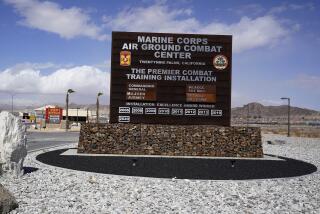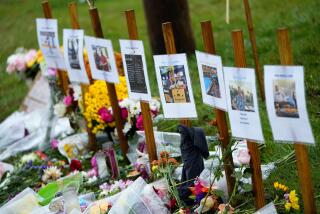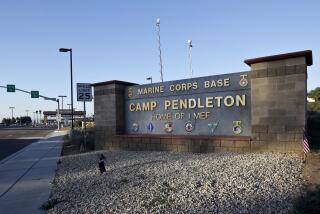Death toll rises to 13 in Ft. Hood shootings
FT. HOOD, TEXAS â In the end, the shooting rampage at Ft. Hood came down to a gunfight between two civilian base police officers toting standard sidearms and a 39-year-old psychiatrist armed with .357 Magnum and a pistol equipped with laser sighting and extra bullets, officials said.
Army Maj. Nidal Malik Hasan, disturbed about his upcoming deployment to Afghanistan (not Iraq, contrary to earlier reports), reportedly entered the Soldier Readiness Processing Center just before 1:30 p.m. Thursday. He took a seat at a table.
It seemed as if he was there to help soldiers who were undergoing medical exams and finishing paperwork before shipping out to war. Hasan, who had prayed at his mosque that morning, allegedly mumbled something to himself -- it may have been a prayer -- then jumped up. Witnesses reported that he said: âAllahu akbar,â Arabic for âGod is great.â
After that, the blood began to flow. Thirteen people would die; 38 others were injured.
As investigators began their probe into the motivations of the gunman, President Obama urged people Friday to reserve judgment until more is known. Base commander Lt. Gen. Robert Cone said that Hasan remained hospitalized, unconscious and on a ventilator.
Friday, as government officials and eyewitnesses gave their accounts, a clearer picture of the attack emerged.
When the shooting began, 138 soldiers were about to celebrate their college graduation with hundreds of relatives and friends in an auditorium nearby. Alarmed, many leaped to their feet, threw off their caps and gowns and rushed to the chaotic scene.
Inside the Readiness Center, Pfc. Marquest Smith, 21, was in a cubicle, across the desk from an employee, finishing paperwork ahead of his deployment in January to Afghanistan.
âAll I heard was popping noises,â Smith said. The noise was followed by something more ominous: screaming and moaning. Then, âSomebodyâs got a gun!â
The next minutes were frenzied. He pushed the employee under her desk. A bullet nicked the heel of his right boot. Outside the cubicle, the scene was grotesque. âThere were chairs, blood, tables,â Smith said.
Smith dragged several victims outside and returned to help others. He kept hearing popping. Then a pause. Then whispers: âHeâs reloading!â Smith saw the gunman, whose back was to him. He ran outside. The gunman fired after him.
It takes seconds to place a new magazine into a pistolâs grip; the gunman reloaded more than once, investigators said, and moved around the crowded room in a half-moon pattern before going outside into a courtyard.
Police Sgt. Kimberly Munley and her partner, Sgt. Mark Todd, heard a radio report and raced toward the action. As the gunman was shooting at a wounded soldier, said Chuck Medley, Ft. Hoodâs director of emergency services, Munley rounded a corner between two buildings and spotted him. They exchanged fire.
A firearms instructor and SWAT team member who had trained for such a moment, Munley shot at the gunman with her 9-millimeter Beretta. He charged her, and they exchanged fire.
Todd, who had become separated from Munley, saw that she had been shot. Hasan was 15 yards from him, Todd told CNN, âstanding there hiding behind a telephone pole waving his weapon, firing it at people.â Todd said Hasan saw him, calmly pointed and shot. Todd couldnât see a weapon -- only a muzzle flash -- and fired back. Hasan, who by then had allegedly shot 100 rounds, fell.
Munley took bullets in each thigh and one in her wrist, which she later dismissed as âminor scratches.â
Smithâs buddy Jeffrey Pearsall, also a 21-year-old private, was sitting in his white Ford F-150 in a nearby parking lot. Suddenly, people began rushing his way. He was confused -- maybe it was a fire? Then he spotted a soldier covered in blood. And right after that, two friends, leaning on each other, pain etched on their faces.
Get in, get in, he urged as they came toward his truck. They got into the truckâs bed. Smith jumped in too, and Pearsall rushed toward the hospital.
âStop!â Smith yelled.
They had left one of their wounded friends behind. Smith hopped out and ran a mile back toward the Readiness Center. His wounded friend already had gotten into his own car and was driving erratically to escape the horrific scene. Smith took the wheel.
At the base hospital, Pearsall pounded on the emergency room door. No answer. He began to panic, and pounded on a window. Finally, a nurse appeared. âWe got people shot that need help!â he said.
Sgt. Andrew Hagerman, 27, a military police officer, was patrolling a residential neighborhood on the base when he heard the distress call on his radio: Shots fired! Officer down!
He sped to the Readiness Center, where he encountered a terrible sight: People were running, bleeding, screaming for medics. Victims were splayed on the ground. Soldiers had torn up their shirts and uniforms to stanch the bleeding of their wounded comrades. Others broke tables to use as stretchers.
The suspected gunman was down, apparently unconscious. Someone shouted to uncuff him so he could get first aid. Was there more than one gunman? Hagerman had no idea. He saw Munley being loaded onto an ambulance. Heâd worked with her a few times and knew she was good at her job.
Hagerman took a moment to assess the situation. After two tours in Iraq, it felt familiar. The floor in the Readiness Center was so bloody that he had to step carefully. As he walked through buildings, he stared hard at the people who remained. Were they OK? Were they hiding something?
Go back and lock your doors, he told them. Then he helped load the wounded onto ambulances.
Maj. Steve Beckwithâs shift was just ending. The 33-year-old director of emergency medical services had been at Darnall Army Medical Center, the base hospital, since 6 a.m. Leaving was out of the question; as gunshot victims began arriving outside, Beckwith jumped in to assess their injuries. He was touched by displays of selflessness. Some drivers had slung shirts together to carry their friends to cars. Soldiers with wounded legs and arms told him to take care of patients with more serious wounds first.
Sgt. Howard Appleby, 31, a combat engineer with two deployments to Iraq under his belt, had an appointment with his psychiatrist. Appleby is grappling with post-traumatic stress disorder and a traumatic brain injury that has left him plagued by headaches, flashbacks and memory loss. His visit was canceled because of the shooting. As he left, he saw ambulances and gunshot victims outside. It reminded him of Iraq -- only there, you just see one guy die a day, he said.
His combat training kicked in. He felt calm and started pulling people out of ambulances. But something about the scene triggered a flashback. As he helped the wounded, he thought, I canât stand to see another person die. He could not help but cry.
Spc. Refugio Figueroa, 22, whose wife is five months pregnant, was at the hospital for her sonogram. After the procedure, he noticed the place was jumping with people in security vests. What was going on? He made some calls, found out and threw himself into action. He helped calm the growing crowd outside. He helped direct traffic.
He was shocked to hear that another soldier was thought to be responsible for the carnage. A spurned boyfriend going crazy, he could understand. But not a soldier. His wife waited for him in the car, phoning her family with the news: Yes, we are safe. And we are having a girl.
Capt. Reis Ritz, 30, an emergency room physician, was finishing some paperwork on his day off. He heard an announcement that trauma victims were coming in. Curious, he went over to the emergency room. A colleague said they needed help.
His first patient, a female soldier, had been shot in the abdomen.
âWho shot you?â he asked.
âI donât know.â
Ritz got a sinking feeling. Something was very wrong.
The hospitalâs dozen or so emergency room beds filled up quickly. As did the half-dozen operating rooms. Some of the wounded needed to be airlifted out, including Hasan. Most of the bullet wounds were in the chest or lower, a blessing in disguise.
Rumors were racing around the hospital: There were four gunmen. There were five gunmen. They were all loose on the base.
After treating the barrage of patients, the staff scrubbed everything down and waited for a second wave of injured. It never came.
On Friday, under a faultless sky at Ft. Hood, Gen. George W. Casey Jr., the Armyâs chief of staff, praised all those who had helped save lives. He singled out Munley, the mother of a 3-year-old girl.
âShe probably saved a lot of lives with her actions,â he said.
Munley has not spoken publicly, but her biography on Twitter seemed especially poignant in light of Thursdayâs events: âI live a good life . . . a hard one, but I go to sleep peacefully @ night knowing that I may have made a difference in someoneâs life.â
--
Times staff writers Robin Abcarian in Los Angeles and Bob Drogin in Killeen, Texas, contributed to this report.
--
(BEGIN TEXT OF INFOBOX)
Victims
Here is a look at some of the 13 people killed when an Army psychiatrist allegedly opened fire at Ft. Hood, Texas:
--
PVT. FRANCHESKA VELEZ
Velez, 21, of Chicago, was pregnant and preparing to return home. A friend of Velezâs, Sasha Ramos, described her as a fun-loving person who wrote poetry and loved dancing. âShe was like my sister,â Ramos said. âShe was the most fun and happy person you could know. She never did anything wrong to anybody.â
--
PFC. AARON THOMAS NEMELKA
Nemelka, 19, of the Salt Lake City suburb of West Jordan, Utah, chose to join the Army instead of going on a mission for the Church of Jesus Christ of Latter-day Saints, his uncle Christopher Nemelka said. âAs a person, Aaron was as soft and kind and as gentle as they come, a sweetheart,â his uncle said. âWhat I loved about the kid was his independence of thought.â
--
PFC. MICHAEL PEARSON
Pearson, 21, of the Chicago suburb of Bolingbrook, Ill., quit what he figured was a dead-end furniture company job to join the military about a year ago. Pearsonâs mother, Sheryll Pearson, said the 2006 Bolingbrook High School graduate joined the military because he was eager to serve his country and broaden his horizons. âHe was the best son in the whole world,â she said. âHe was my best friend, and I miss him.â
--
SPC. JASON DEAN HUNT
Hunt, 22, of Frederick, Okla., went into the military after graduating from Tipton High School in 2005 and had gotten married just two months ago, his mother, Gale Hunt, said. He had served 3 1/2 years in the Army, including a stint in Iraq. Hunt, known as J.D., was âjust kind of a quiet boy and a good kid, very kind,â said Kathy Gray, an administrative assistant at Tipton Public Schools. His mother said he was family-oriented. âHe didnât go in for hunting or sports,â she said. âHe was a very quiet boy who enjoyed video games.â
--
MICHAEL GRANT CAHILL
Cahill, a 62-year-old physician assistant, of Cameron, Texas, had a heart attack two weeks ago and returned to work at the base as a civilian employee after taking one week off for recovery, said his daughter Keely Vanacker. âHe survived that. He was getting back on track, and he gets killed by a gunman,â Vanacker said. Cahill helped treat soldiers returning from tours of duty or preparing for deployment. Often, Vanacker said, Cahill would walk young soldiers where they needed to go, just to make sure they got the right treatment. âHe loved his patients, and his patients loved him,â said Vanacker, 33, the oldest of Cahillâs three adult children. âHe just felt his job was important.â
--
SGT. AMY KRUEGER
Krueger, 29, of Kiel, Wis., joined the Army after the Sept. 11 terrorist attacks and had vowed to take on Osama bin Laden, her mother, Jeri Krueger, said. Amy Krueger arrived at Ft. Hood on Tuesday and was scheduled to be sent to Afghanistan in December. Jeri Krueger recalled telling her daughter that she could not take on Bin Laden by herself. âWatch me,â her daughter replied.
--
PFC. KHAM XIONG
Xiong, 23, of St. Paul, Minn., a 2004 graduate of Community of Peace Academy, enjoyed hunting and fishing. âThe sad part is that he had been taught and been trained to protect and to fight. Yet itâs such a tragedy that he did not have the opportunity to protect himself and the base,â his father, Chor Xiong, told the Twin Cities news broadcast KSTP-TV through an interpreter.
--
Source: Associated Press
More to Read
Sign up for Essential California
The most important California stories and recommendations in your inbox every morning.
You may occasionally receive promotional content from the Los Angeles Times.










